Safely transporting explosives by road requires utmost precaution and adherence to strict safety measures to prevent any mishaps or potential disasters. The transportation of explosives such as dynamite, fireworks, or hazardous chemicals demands specialised knowledge, rigorous training and extensive planning.
Where transportation is necessary, it is crucial to employ an experienced ADR carrier for explosive goods. This way, consignors can have total confidence in both the transportation method and all personnel involved, guaranteeing the safe transport of their shipment.
Below we will explore the key considerations of class 1 explosive goods transport, including a full explanation of the classes, hazards and potential consequences of mishandling these articles.
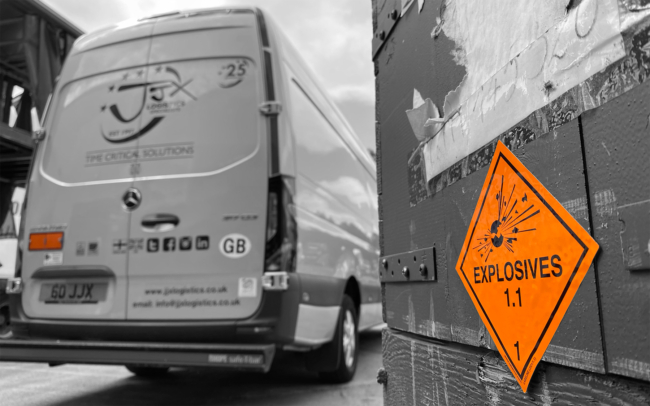
Definition of Explosive Materials and Class 1 Materials
Explosive materials cover a range of substances that under certain conditions have the potential to rapidly release energy in the form of light, heat, sound and a shock wave. This reaction can be triggered by factors, like heat, a spark or an impact. Some of the most closely regulated goods fall under classes 1.1 and 1.2, which have the most potential to cause extensive damage and loss of life if mishandled.
In the context of hazardous goods and ADR safety regulations, explosive materials fall under Class 1. This classification is based on their ability to cause an explosion that affects the entire load instantly or presents hazards from projectiles or fire.
It is essential to distinguish Class 1 materials from other classes to ensure they are handled, stored and transported with utmost care while complying with specific regulations to prevent accidental detonation.
Common Examples of Class 1 Explosive Materials
Fireworks:
Fireworks typically contain a combination of chemicals, including gunpowder, that combust and explode to create various colourful and dazzling effects when ignited. Fireworks can range from small handheld devices to large aerial shells.
Pyrotechnics:
Pyrotechnics refer to a broader category of explosive devices used for applications including entertainment, signalling and special effects. Pyrotechnics utilise a combination of chemical compounds that, when ignited, produce light, heat, smoke, or sound effects.
Ammunition & Propellant:
Ammunition includes various types of explosive materials used in firearms, such as bullets, shells and cartridges. Propellants can be solid, such as gunpowder or smokeless powder, or liquid, like rocket propellants.
Detonators:
Detonators, also known as blasting caps or initiators, are small explosive devices used to initiate larger explosions or detonations. They are commonly used in mining, construction and demolition industries. Detonators contain a small amount of sensitive explosive material that can be easily triggered by heat, shock, or electrical current.
Blasting agents:
Blasting agents are mixtures used in mining, quarrying and construction industries for controlled explosion purposes. Blasting agents often consist of a mixture of chemicals, including ammonium nitrate, fuel oil and other additives, which provide controlled explosive power when properly initiated.
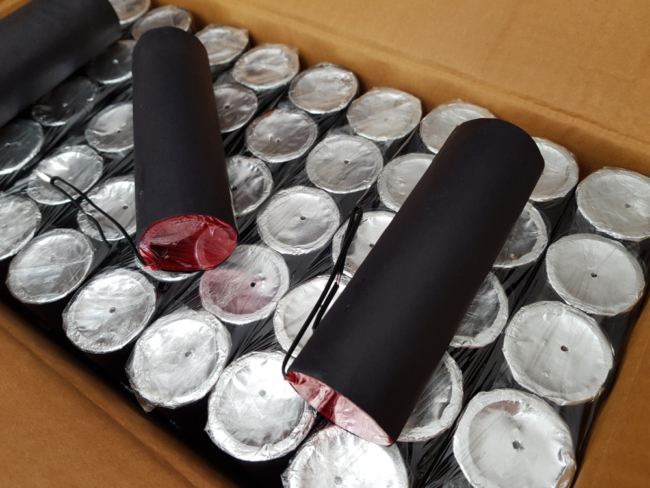
Categories of Class 1 Explosive Materials
Class 1 explosive materials are further categorised based on their characteristics, such as their sensitivity to initiation, their net explosive mass (NEM/NEQ) and the specific risks they pose. By understanding the unique characteristics of different explosive materials within Class 1, couriers and consignors can ensure the highest level of safety and security in their handling.
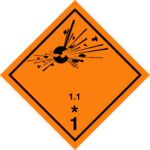
Class 1.1: Mass Explosion Hazard
Class 1.1 explosive materials include substances and articles that have a mass explosion hazard. This division has the potential to cause an explosion that affects almost the entire load instantaneously. They typically contain extremely sensitive and powerful explosives, such as TNT (Trinitrotoluene), RDX (Research Department Explosive) and even military-grade explosives. Due to their high explosive power, Division 1.1 materials are generally considered to be highly dangerous. Due to the potential consequences of mishandling being catastrophic, it is crucial for those working with Division 1.1 explosives to receive proper training.
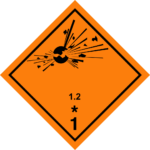
Class 1.2: Blast & Projection Hazard
Class 1.2 explosive materials refers to substances that have a projection hazard but not a mass explosion hazard. These materials can release a significant amount of energy when ignited, but they do not result in a widespread explosion due to their inherent properties. They are typically characterised by their ability to propel fragments or debris at high speeds upon detonation. Due to their projection hazard, these materials can pose a significant risk to people and property in the immediate vicinity of the explosion.
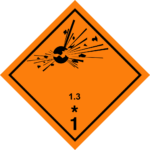
Class 1.3: Fire Hazard
Class 1.3 pertains to substances and articles that present a fire hazard and a minor explosion hazard. This classification includes certain detonating cord and small arms ammunition. While these materials can cause fires, they are less likely to produce large explosions. Division 1.3 substances and articles must be handled with care and stored in appropriate conditions to minimise the risk of combustion.
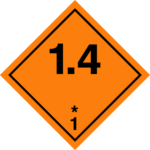
Class 1.4: No Significant Blast Hazard
Class 1.4 includes substances that are sensitive to ignition but do not propagate a detonation or transition from deflagration to detonation. This category encompasses fireworks and pyrotechnic items that are commonly used for entertainment purposes. Fireworks, such as sparklers and firecrackers, fall under this division due to their relatively low hazard level. While the risk is lower compared to other explosive classes, they can still cause harm if mishandled and require proper labelling and attention to safety guidelines.

Class 1.5: Blasting Agents
Class 1.5 or blasting agents are very insensitive substances that have a mass explosion hazard. Blasting agents are designed to be less susceptible to detonation and require a substantial amount of energy to initiate an explosion. Blasting agents are commonly used in mining, construction and quarrying industries for activities such as rock blasting and excavation. While this division is relatively less volatile than others, it is essential to handle these materials with utmost caution and adhere to proper storage and transportation procedures.

Class 1.6: Very Insensitive Articles
Class 1.6 explosives are extremely insensitive articles that do not have a mass explosion hazard. Even if a large quantity of these explosives is present, the explosion will remain confined to the individual articles only, without propagating to nearby materials. Due to their more stable nature, Class 1.6 explosives have a reduced risk of accidental initiation, making them suitable for handling and transportation with less stringent safety precautions compared to other explosive materials. However, it is still essential to adhere to proper storage, handling and transportation procedures to ensure the utmost safety when dealing with these materials.
Hazards Associated with Class 1 Explosives
When it comes to transporting Class 1 explosives by road it's not a matter of moving goods from one place to another. These materials bring about hazards due to their very nature. The obvious danger is the potential for an explosion, particularly with division 1.1 substances. Such an explosion can have consequences which include completely destroying the vehicle and also causing extensive damage to the surrounding area, posing significant risks to human lives and the environment.
There is also a risk of fragments being projected, especially from Division 1.2 explosives, in the event they detonate. Even without a full scale explosion these fragments can cause grievous injury or damage, posing further risk to property and life. Furthermore, while division 1.3 materials may not project significantly, their explosive potential can quickly cause and spread fire with alarming rapidity, which poses secondary hazards especially in areas where further flammable or explosive substances are present.
Accidents are unpredictable by nature, such as road collisions or vehicle malfunctions. This means that even divisions like 1.4 which might be considered less risky cannot be taken lightly. While the risk may be minimal, an unexpected detonation in a populated area or on a roadway can lead to disastrous consequences.
An Overview of the Safety Regulations and Procedures for Transporting Explosive Materials
Transporting materials that are explosive via road requires adherence to safety regulations in order to mitigate the inherent risks. These regulations are designed to prioritise safety and are regularly reinforced by both international and local standards.
Preparing for Transport
Before transporting explosives by road, comprehensive checks are imperative. Firstly, ensure the materials are correctly classified, labelled and packed. A detailed transport document, mentioning the quantity, type and hazard classification, should accompany the shipment. The chosen vehicle must be inspected for any mechanical flaws and equipped with necessary safety equipment, such as fire extinguishers.
The selection of transportation routes requires prior approval with a focus on the following:
- Avoiding populated areas where possible.
- Adhering to a pre-prepared route.
- Avoid parking near tunnels, bridges or crowded areas.
Furthermore, these routes should be closely monitored through the use of tracking systems. In order to effectively respond to any incidents or diversions that may occur along the way, robust emergency response plans need to be put in place. Lastly, communication channels must be set up, enabling real-time tracking and immediate response in case of deviations or emergencies.
How to Safely Package Class 1 Materials
Ensuring the transportation of Class 1 explosives heavily relies on packaging. It is crucial to use packages that are specifically designed and tested according to the quantity and type of material being transported. The package should be robust and capable of reducing the risk of any explosion or projection while being able to withstand shocks, drops and punctures.
To minimise friction between items, internal packaging such as dividers can be employed. It may also be necessary to seal divisions in order to prevent moisture or contaminants from compromising the explosive substance.
All packaging must be well-labelled to indicate the presence of hazardous materials and any special handling requirements. The outer packaging should display the appropriate shipping name, UN number and hazard class/division. Furthermore it is vital to conduct preliminary inspections for any signs of wear, damage or tampering on packages or enclosures.

Proper Labelling and Documentation Requirements
Proper documentation and labelling are prerequisites when transporting Class 1 explosive materials. The label should clearly display the class and division of the explosive, ensuring quick identification. Labels often feature distinct colours and symbols to communicate the hazard level. An orange label indicates an explosive, accompanied by a compatible division number.
As for documentation, the courier must have a detailed record specifying the explosive's name, UN number, class, packing group and quantity. Additionally, an emergency action plan and contact numbers should be readily available. Documents should also outline any special instructions for handling and storage. Ensuring these are accessible and up-to-date is crucial, not only for adherence to legal obligations but to guarantee the safety of personnel, public and environment throughout the transportation process.
Training and Certification
Ensuring the proficiency of those handling explosives is paramount. Personnel must undergo comprehensive ADR training that covers the intricacies of the materials they'll transport. This encompasses the properties of the explosives, appropriate handling procedures, emergency response protocols and first-aid measures specific to explosive-related injuries.
Once training concludes, evaluations are administered to assess the competency of the personnel. Only upon passing these assessments are certificates issued, validating their ability to transport explosives safely. It's crucial to remember that the landscape of explosive transportation constantly evolves and periodic refresher courses are mandatory to keep staff updated with new safety standards.
Security Measures That Can be Implemented During Transport
The transportation of explosive goods presents significant security risks that need to be addressed through the implementation of effective security measures. This requires the commitment and expertise of both the consignor and courier.
A robust security system can include a combination of physical measures, appropriate procedures and the dedication of trained personnel. Though the particular techniques of physical security may differ based on the location, there are some shared features, including:
- Physical and electronic security measures
- Alarm systems or CCTV
- Access control
- Personnel searches
Before setting off, the driver should be made aware of any potential security risks local to regions he/she is travelling through as well as the nature of their explosive cargo. During transport, it is important to ensure the supervision of any explosives, particularly when parked, to reduce the risk of theft or tampering. Providing the driver of the vehicle transporting the explosive goods with a reliable method of communication allows them to report any security concerns or emergencies promptly.
Potential Consequences of Mishandling Explosive Goods
Transporting materials that are explosive via road requires adherence to safety regulations in order to mitigate the inherent risks. These regulations are designed to prioritise safety and are regularly reinforced by both international and local standards.
Detonation of Explosives
Transporting materials that are explosive via road requires adherence to safety regulations in order to mitigate the inherent risks. These regulations are designed to prioritise safety and are regularly reinforced by both international and local standards.
Legal Repercussions
Beyond the immediate physical risks, improperly handling or transporting explosives can have severe legal repercussions. Entities involved could face hefty fines, suspension of licences, or even criminal charges. The reputational damage to the company responsible can be immense, making future business operations challenging.
Environmental Damage
Environmental consequences shouldn't be understated either. Explosions can lead to fires, affecting flora and fauna, or the release of toxic substances, contaminating soil and water sources. Adherence to transportation protocols is not just about avoiding immediate hazards, but also safeguarding the environment and ensuring a company's long-term viability.
Consignors, carriers and recipients should possess a thorough understanding of the Carriage of Dangerous Goods Regulations. It is crucial to guarantee full adherence to ADR guidelines for the substances you intend to store and transport.
Non-compliance may result in legal repercussions, potential harm, or even loss of life. If you have any uncertainties regarding the procedural demands for your cargo, it is advisable to reach out to an expert ADR transporter for more advice.
We're ready when you need us

